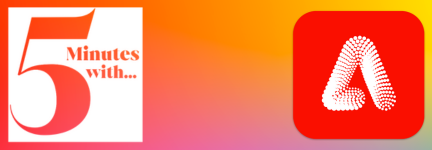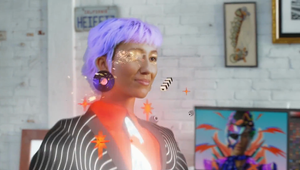
5 Minutes with… Deepali Nayar

Adobe XD is a proud supporter of LBB. Over the upcoming months, as part of the sponsorship of the ‘5 Minutes with…’ channel, we will be spending time with some of the most innovative and creative minds in the industry.
Deepali Nayar’s childhood love of art - complete with art day Sundays - were the foundation of the creative mind she applies to craft of digital design. With over 15 years of experience, she has worked on projects for giants like Unilever, Huawei, and Citibank.
For Deepali, great design is necessarily rooted in experience-based solutions and she believes that brands should always invest in user research first, using data garnered to make smart decisions. Deepali’s role is naturally collaborative as she works with illustrators, art directors, account executives, and copywriters to deliver work every can be proud of with a “no egos” approach to creative leadership.
Today, Deepali tells LBB about where India is succeeding most over other markets, why most memorable project involved relocating to Hong Kong for a month, and the reason she loves spending time in nature.
LBB> How did you get your start in the industry? Was this always the plan for you?
Deepali> My earliest memories of art stem from when I was about three years old. My parents would encourage me to sketch whatever I saw around me. Before I knew it, Sundays became ‘art days’ in our household and I’d spend time honing my craft. As I grew up, I enrolled in Wigan and Leigh College from where I landed my first internship in OgilvyOne in New Delhi. Thereon, as the industry and technology changed, I progressed from a career in advertising and graphics to UI and UX work, mainly motivated by my inclination to learn new things. It’s been a fruitful journey since.
LBB> You’ve worked at Publicis Sapient for over 13 years. How have you seen the company evolve in that time?
Deepali> While Publicis Sapient may have evolved in many public ways in the 13 years that I’ve been here – be it our strategic approach or how we meet customer needs – at its core, its values have remained constant. The culture at Publicis Sapient is the backbone of what makes the company unique and it’s one of the few places where ‘people first approach’ is not just a fancy jargon but a mindset. Every member has a voice and a platform where they are heard and get opportunities that empower them to create a real impact with their work. There is openness and transparency when it comes to dealing with clients on an equal footing as partners, and there is enormous fluidity and growth that help propel individual journeys.
LBB> We’d love to hear your thoughts on digital design and how it's approached in India - what's different about it compared to other markets?
Deepali> Digital design in India is defined by simplicity, functionality and reliability. In particular, if we look at the progress made by the finance and telecommunications sectors in digital design, we’ll see that Indian designers are well ahead of the curve and are setting global benchmarks. What sets the Indian digital design approach apart is that it is forward-looking and visionary while at the same time being trustworthy and thoughtful of end-user needs.
LBB> What are the main challenges facing brands today? Do you think any brands are solving them well right now?
Deepali> There are two aspects that brands often struggle with – one is user research and the other is quality and usability testing. In every vertical today, there are multiple players trying to achieve similar outcomes. In this context, it becomes imperative that brands invest in user research that creates a strong foundation for design solutions. Research also helps create an unbiased view of the playing field and the end-user. This is crucial for building impactful products.
Next in this context, brands need to invest heavily in quality/usability testing to ensure that the overall package being created is well-groomed. This helps to test and course-correct the product/solution much in advance with the right set of users, leading to a robust rollout of the product/solution in the wider market.
Amidst all the chaos, there are some brands, especially a couple of telecom giants that are investing in data-backed user research and quality testing in phased releases to deliver optimum quality to their end customers in an iterative manner. These are the ones winning the race!
LBB> You oversee a team of creatives - how do you get the best out of everyone while aligning this with client needs too?
Deepali> I’m fortunate to work with a team that is collaborative, resourceful and creative. And while I don’t follow leadership mantras per se, I follow my gut when it comes to keeping my team honest, open and productive. Creating a culture where we have each other’s back at all times is the key. There are also no egos when it comes to creativity as it supersedes one’s age or years of experience. And to keep the creative juices flowing, we ensure that we’re constantly learning something new. This keeps our perspective fresh.
LBB> Why are experience-based solutions key to great design? What does this look like in practice?
Deepali> In general practice, clients are typically focused on receiving basic design services. They are not naturally inclined towards experience-based solutions, either due to limited understanding or restrictive budgets. In today’s tech landscape, anything and everything imaginable can be implemented on a robust platform. But it is only when UI and UX come into play that we can determine if the end users are able to use the solution seamlessly.
When clients see how robust UI and UX lead to creating light, ethical, accessible and dataful experiences, they understand the benefits of incorporating findings from ergonomic studies, user research exercises and usability tests that are essential to creating a seamless experience. These experience-based solutions in turn lead to a positive impact on how customers experience our clients’ solutions in the real world.
LBB> What has been the most memorable project from your career?
Deepali> Once my team was commissioned to work with a Hong Kong-based client and deliver a website in a month’s time. This project was on tenterhooks and as a team ensuring client satisfaction was paramount. We were a team of five people from different domains. We relocated onsite, sat with our clients every single day to understand their requirements, and delivered work with optimum quality. At an onsite location, there can be challenges such as food, weather and language. But the team worked day and night despite the challenges to achieve this incredible, time-bound goal.
Along the way, we squeezed in some fun too! On this project, I realized how a happy team can rally together against all odds and achieve fantastic outcomes.
This was also when I realized that it does take us Indians a while to build our creative credibility in the global space, as we are usually considered a production hub. But, once we build that trust and authority through our work, there’s no going back – it changes people’s mindset toward us.
LBB> How do you stay inspired? What do you look like to read/watch outside of work?
Deepali> I love being in nature so much so that my workstation is always by a window looking out at the open sky. It helps me clear my mind and transforms it into a blank canvas to allow creative ideas and inspiration to flow in. I also go on treks to be closer to nature and build resilience. I practice meditation too, as it helps to restore my energy. When I’m home, I binge-watch sports documentaries and light-hearted films. Music that resonates with my mood uplifts me as well, and I enjoy photography too. Every once in a while, I pick up a good book for inspiration.















